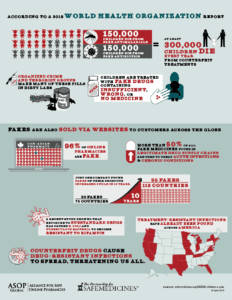Peer-reviewed journal article estimates 300,000 child fatalities annually due to counterfeit medication

See PSM’s infographic for a visual summary.
New infographic helps explain deadly impact counterfeit medicines have, where they come from, and how they contribute to microbial resistance.
WASHINGTON (June 17, 2019) – The Partnership for Safe Medicines and the Alliance for Safe Online Pharmacies (ASOP Global), two public health advocacy groups focused on patient safety and the secure pharmaceutical supply chain, released an infographic today to call attention to the human toll that counterfeit medicines take on children in low and middle income countries.
A peer-reviewed article in The American Journal of Tropical Medicine and Hygiene identifies the economic and human impact of counterfeit medicines. The article, authored by top-flight researchers from the National Institutes of Health, University of California – San Diego School of Medicine, US Pharmacopeial Convention, Pfizer’s Global Security Team, and the University of North Carolina at Chapel Hill, estimates that counterfeit rates are as high as 10% of all medicines in low and middle income countries, and puts a specific estimate on child fatalities.
“It’s a tragedy that 300,000 children die annually because of the greed of counterfeiters,” said Libby Baney, partner at Faegre Baker Daniels Consulting and senior advisor to ASOP Global. “Even worse is the fact that many of these senseless fatalities could be avoided by cracking down on the illegal online pharmacies that peddle dangerous and deadly fake medicines.”
Along with estimating the death toll of counterfeits, the paper also confirms the fact that counterfeit medicine is a driver of antimicrobial resistance. “Counterfeits are often made with a partial dose of active ingredient in order to fool simple chemical tests,” said Shabbir Imber Safdar, Executive Director of the Partnership for Safe Medicines. “Even worse than failing to treat your disease, these counterfeits are breeding a generation of super diseases that we don’t have treatments for. American policymakers need to understand this threat and take steps to strengthen the existing supply chain to protect us.”
You can see a copy of the infographic and read the paper at PSM’s website: https://www.safemedicines.org/2019/04/300000-children-a-year.html